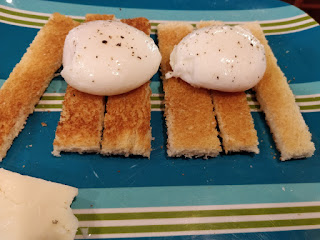Anova Precision Sous Vide Review
Sous vide cooking has been reaching public attention for about 10 years, with the rise of food bloggers and professional chefs broadcasting on YouTube. Immersion circulators have been used in restaurants for a long time before that. The idea is pretty simple: create a water bath that stays at a constant temperature, and you can cook food in it until the perfect done-ness is achieved. The sous vide part means "under vacuum" in French and refers to the fact that you generally seal the food in a vacuum bag before immersing in the water bath.
Recently, I purchased an Anova Sous Vide Precision Cooker, which is one of many sous vide circulator devices available to consumers. The price varies between from about $90 to well over $500. This model cost $150 at Best Buy, and is even cheaper on Amazon.
These mostly all work the same way: you fill a vessel with water, attach the circulator to the vessel with the heating element in the water, and set the temperature you want. The Anova includes bluetooth and a mobile app, so you can scroll through recipes and send the time and temperature you want directly to the device. Honestly, the connection to the mobile app only worked when standing very close to the machine, which sort of eliminates any sort of convenience or reason for this feature.
The first day I brought the Anova home, I made some thick steaks in it. Unfortunately, I didn't take any pictures. The steak cooked to a perfect 130°F in 2 hours and was the most tender I've ever made. When I pulled the bag out of the water bath, the meat was all gray, so the final step with most sous vide recipes is to sear the meat in a pan. I used my Searzall, which achieved the same effect.
I wanted to try making poached eggs with the Anova, since this method of cooking them is said to be the best. As you can see from the banner picture, they turned out amazingly well. I've never been able to consistently master poached eggs on the stovetop and I was hopeful this would be foolproof.
This is my set up. I am using a large ice bucket that was given to us as an anniversary gift years ago- it's large enough to hold a lot of water, and it has insulated sides to help retain the heat. The circulator clamps to the side and the heating element is immersed in the water. At the bottom of the heating element is a small fan that moves the water around and keeps temperatures even throughout. If you are only making a small amount of food, use a smaller container- a soup pot or sauce pan would work just fine.
I do not have a vacuum sealer, and in my opinion you don't need one. Put the food you want to cook in a regular Ziplok bag, and slowly lower the bag into the hot water. As you do so, the heat will force the air out of the bag, and once you get to the top of the bag you just seal it up.
Here's the control interface. Basically, you use that blue scroll wheel to change the time or temperature, and the Play/Pause button to start it. Again, you can use the mobile app to control this as well.
The hot water from my tap is about 128°F at the hottest, so I filled the ice bucket up with that. Once the circulator started, it only took a few minutes for the water to reach 146°F, my target temperature for the eggs.
There are two methods to cooking poached eggs- low and slow, or fast and hot. I chose the first option, cooking 4 eggs for 50 minutes at 146°. The other method is to set your temperature for 167°F and cook for only 15 minutes.
An optional step to making poached eggs the low and slow method is to finish the eggs in a simmering pan of water on the stovetop for about 30 seconds. This firms up the egg white, and I prefer this in my poached eggs, so I took this extra step.
As you can see, the results were perfect. The egg white was set but not hard, and the yoke was creamy, hot and runny. Delicious!
Now, this whole process took about an hour, which is a long time to wait for poached eggs. The hot and fast method is much quicker, and you don't need to finish them in simmering water. What I have read is that, depending on the size of your eggs, the yoke may be more or less runny. I figured for the first test, I would go the extra distance.
A nice shortcut to having poached eggs in a hurry would be to cook them the night before, and then put them immediately into a bowl of ice water. In the morning, you can heat up a pan of simmering water and cook the eggs for 1 minute. That's a nice way to have some eggs ready for breakfast in a hurry.
An advantage to the Anova is that I can make a lot of eggs at one time. My vessel is large enough (and the Anova is powerful enough) to cook 18 eggs at once. For feeding a large family like mine, this is a big point in its favor. With a smaller machine, it might be a struggle to keep the water temperature up. When I cooked those steaks, I was able to cook 8 6oz steaks in two bags at one time.
I'm planning to experiment with lots of different foods using the Anova, and I'll post a few more pictures as time goes on. The performance of the Anova was excellent, with the exception of the wireless connectivity- from some cursory research, many people have trouble getting it to work right. For me, that's disappointing but not a deal breaker, as I prefer to set the time and temperature right on the device itself.
For a large family, or if you like to entertain often, the Anova Precision Sous Vide Cooker is a great device. Highly recommended.







Comments